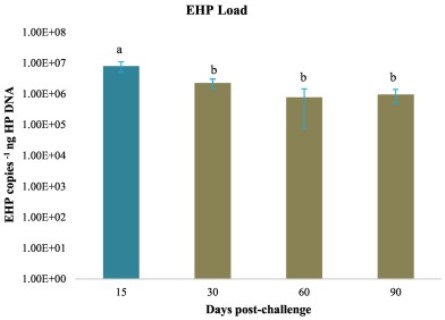Enterocytozoon hepatopenaei (EHP), the shrimp microsporidian, has been a serious threat to the shrimp aquaculture industry in recent years. The target organ for this intracellular microsporidian is shrimp hepatopancreas (HP); henceforth, the disease caused by EHP is named as hepatopancreatic microsporidiosis (HPM). The hepatopancreas (HP) is the most important digestive gland responsible for secretion, digestion, absorption, storage, and metabolism. In this study, EHP challenged shrimp were reared up to 90 days and simultaneously investigated for digestive, physiology, immune, and growth responses at different time intervals and compared to control. Histology revealed severe necrotic HP tubules and epithelial cells, EHP developmental stages, and mature spores in epithelial cytoplasm and HP tubule lumen in the challenged group. The digestive enzymes α-amylase and lipase were significantly (P < 0.05) reduced in the EHP challenged group. The metabolic variables such as triglycerides (TG), total protein (TP), cholesterol (CL), glucose (GL), and alanine aminotransferase (ALT) were significantly (P < 0.05) low in EHP challenged group. EHP infection significantly (P < 0.05) affected the non-specific immune response by decreasing the activity of alkaline phosphatase (ALP), catalase (CAT), γ- glutamyl transferase (GGT), total antioxidant capacity (T- AOC), superoxide anion (SOA), phenoloxidase (PO), and total hemocyte count (THC). After 90 days, the growth of challenged animals was only 12.17 ± 0.80 g, while control was 19.27 ± 0.5 g. The average daily weight gain of challenged animals was 96.72 ± 10.2 mg, and the control was 175.34 ± 5.9 mg. The FCR of the challenged group was 3.01 ± 0.29, whereas the control was 1.64 ± 0.05. However, shrimp (71.1%) survive EHP infection for 90 days. Thus, the severe damage caused by EHP in HP affected the secretion, digestion, absorption, and storage processes. These repercussions affected the physiology, lipid metabolism, carbohydrate metabolism, immune system and caused reduced feed consumption, elevated FCR, and growth retardation. In conclusion, EHP infection did not cause mass mortality but significantly retard the shrimp’s growth, thereby increasing the production cost and resulting in severe economic losses in shrimp farms.
Effect of Enterocytozoon hepatopenaei (EHP) infection on physiology, metabolism, immunity, and growth of Penaeus vannamei
